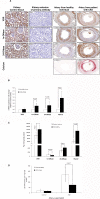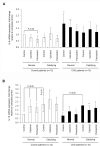Impaired arterial vitamin D signaling occurs in the development of vascular calcification
- PMID: 33211721
- PMCID: PMC7676703
- DOI: 10.1371/journal.pone.0241976
Impaired arterial vitamin D signaling occurs in the development of vascular calcification
Abstract
Conflicting data exists as to whether vitamin D receptor agonists (VDRa) are protective of arterial calcification. Confounding this, is the inherent physiological differences between human and animal experimental models and our current fragmented understanding of arterial vitamin D metabolism, their alterations in disease states and responses to VDRa's. Herein, the study aims to address these problems by leveraging frontiers in human arterial organ culture models. Human arteries were collected from a total of 24 patients (healthy controls, n = 12; end-stage CKD, n = 12). Cross-sectional and interventional studies were performed using arterial organ cultures treated with normal and calcifying (containing 5mmol/L CaCl2 and 5mmol/L β-glycerophosphate) medium, ex vivo. To assess the role of VDRa therapy, arteries were treated with either calcitriol or paricalcitol. We found that human arteries express a functionally active vitamin D system, including the VDR, 1α-hydroxylase and 24-hydroxylase (24-OHase) components and these were dysregulated in CKD arteries. VDRa therapy increased VDR expression in healthy arteries (p<0.01) but not in CKD arteries. Arterial 1α-OHase (p<0.05) and 24-OHase mRNA and protein expression were modulated differentially in healthy and CKD arteries by VDRa therapy. VDRa exposure suppressed Runx2 and MMP-9 expression in CKD arteries, however only paricalcitol suppressed MMP-2. VDRa exposure did not modulate arterial calcification in all organ culture models. However, VDRa reduced expression of senescence associated β-galactosidase (SAβG) staining in human aortic-smooth muscle cells under calcifying conditions, in vitro. In conclusion, maladaptation of arterial vitamin D signaling components occurs in CKD. VDRa exposure can exert vasculo-protective effects and seems critical for the regulation of arterial health in CKD.
Conflict of interest statement
The authors have read the journals policies and the authors of this paper declare the following competing interests: DZ was supported by an unrestricted research grant from Abbott Laboratories. This does not alter our adherence to PLOS ONE policies on sharing data and materials.
Figures





Similar articles
-
Functional cooperation between vitamin D receptor and Runx2 in vitamin D-induced vascular calcification.PLoS One. 2013 Dec 12;8(12):e83584. doi: 10.1371/journal.pone.0083584. eCollection 2013. PLoS One. 2013. PMID: 24349534 Free PMC article.
-
Vitamin D receptor activators induce an anticalcific paracrine program in macrophages: requirement of osteopontin.Arterioscler Thromb Vasc Biol. 2010 Feb;30(2):321-6. doi: 10.1161/ATVBAHA.109.196576. Epub 2009 Nov 30. Arterioscler Thromb Vasc Biol. 2010. PMID: 19948844 Free PMC article.
-
In vascular smooth muscle cells paricalcitol prevents phosphate-induced Wnt/β-catenin activation.Am J Physiol Renal Physiol. 2012 Oct 15;303(8):F1136-44. doi: 10.1152/ajprenal.00684.2011. Epub 2012 Aug 8. Am J Physiol Renal Physiol. 2012. PMID: 22874762
-
Vitamin D receptor activation and prevention of arterial ageing.Nutr Metab Cardiovasc Dis. 2012 Jul;22(7):547-52. doi: 10.1016/j.numecd.2012.03.010. Epub 2012 May 24. Nutr Metab Cardiovasc Dis. 2012. PMID: 22633189 Review.
-
Cardiovascular disease in chronic kidney failure: the role of VDR activators.Curr Opin Investig Drugs. 2006 Mar;7(3):206-13. Curr Opin Investig Drugs. 2006. PMID: 16555680 Review.
Cited by
-
Vitamin A, D, E, and K as Matrix Metalloproteinase-2/9 Regulators That Affect Expression and Enzymatic Activity.Int J Mol Sci. 2023 Dec 1;24(23):17038. doi: 10.3390/ijms242317038. Int J Mol Sci. 2023. PMID: 38069361 Free PMC article. Review.
-
Vitamin D Supplementation Has No Impact on Cardiorespiratory Fitness, but Improves Inflammatory Status in Vitamin D Deficient Young Men Engaged in Resistance Training.Nutrients. 2022 Dec 13;14(24):5302. doi: 10.3390/nu14245302. Nutrients. 2022. PMID: 36558461 Free PMC article. Clinical Trial.
-
Ferroptosis and Preeclampsia: Genetic Analysis of Potential Biomarkers and Therapeutic Targets.Biochem Genet. 2024 Apr;62(2):853-875. doi: 10.1007/s10528-023-10449-y. Epub 2023 Jul 20. Biochem Genet. 2024. PMID: 37474873
-
Vitamin D Supplementation Does Not Enhance Gains in Muscle Strength and Lean Body Mass or Influence Cardiorespiratory Fitness in Vitamin D-Insufficient Middle-Aged Men Engaged in Resistance Training.Nutrients. 2024 Oct 2;16(19):3356. doi: 10.3390/nu16193356. Nutrients. 2024. PMID: 39408324 Free PMC article. Clinical Trial.
-
Inflammation: a putative link between phosphate metabolism and cardiovascular disease.Clin Sci (Lond). 2021 Jan 15;135(1):201-227. doi: 10.1042/CS20190895. Clin Sci (Lond). 2021. PMID: 33416083 Free PMC article. Review.
References
Publication types
MeSH terms
Substances
Grants and funding
LinkOut - more resources
Full Text Sources
Medical
Miscellaneous

